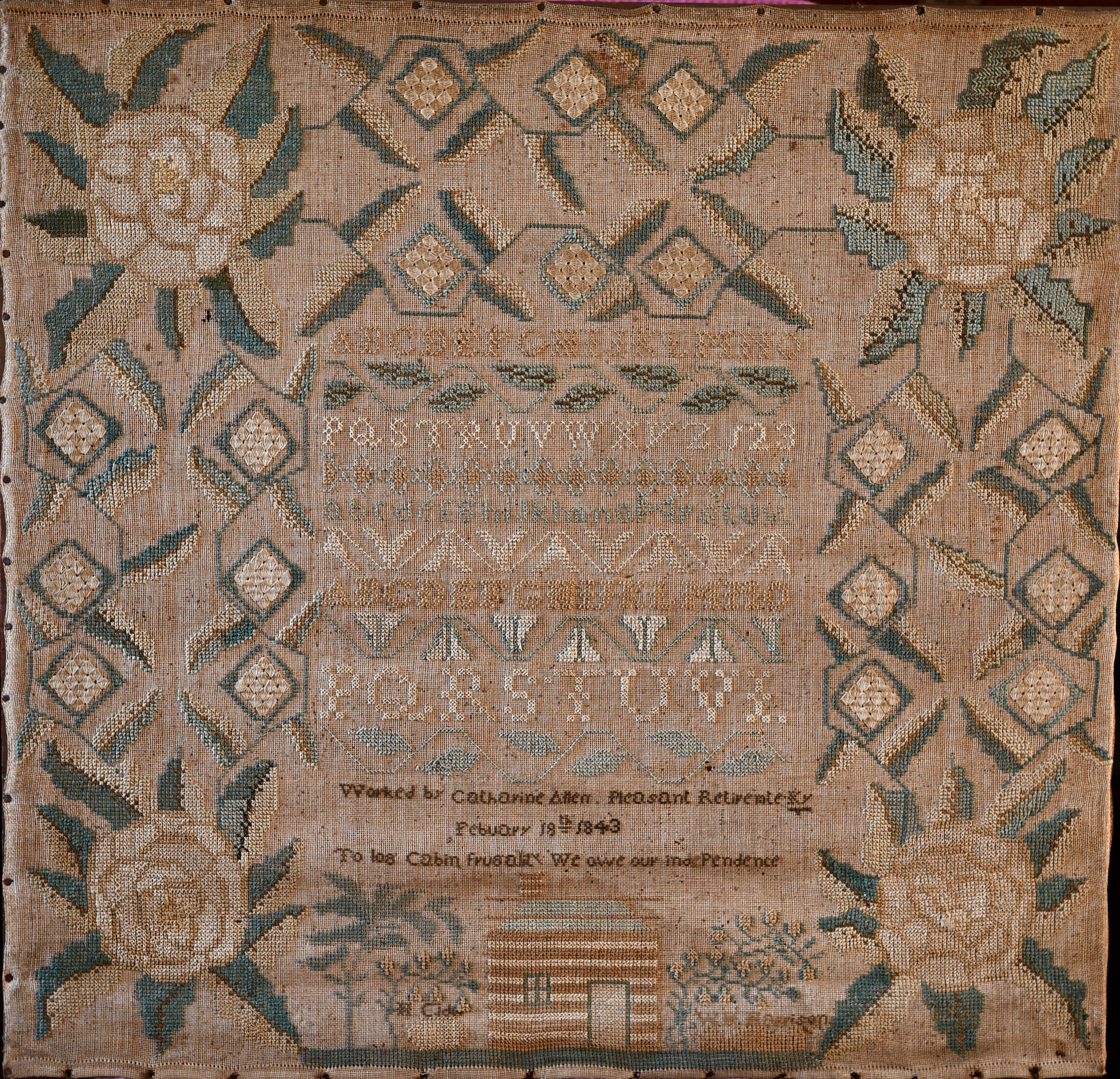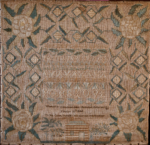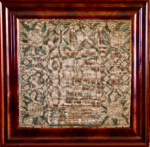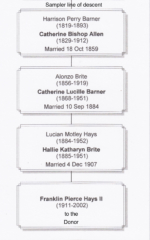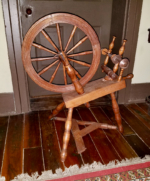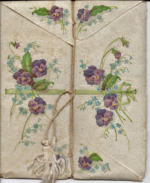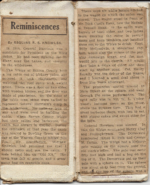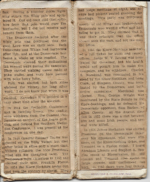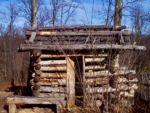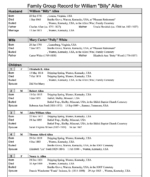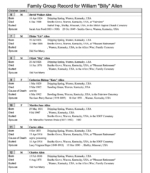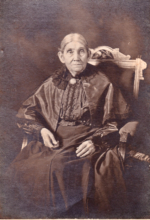Sampler
Maker's Name
Allen, Catherine
Location
Warren County, Kentucky
Date Made
1843
Maker's Age
14 years old, born March 1, 1829
Dimensions
24 ¾ x 24 ¼ inches
Medium
Silk on linen with cross, four-sided, queen and rice stitches; thread count: 23/inch horizontal, 24/inch vertical
Provenance
Made by Catherine Bishop "Kate" Allen in 1843. The sampler has remained within the family from 1843 until today, now owned by her great, great grandson, Private Collector #27. The sampler passed from Catherine Bishop "Kate" Allen Barner to Catherine Lucille "Kate" Barner Brite, to Hallie Katharyn Brite Hays, to Franklin Pierce "Frank" Hays, to the current owner, Private Collector #27. It resides today within the same home where Catherine Allen lived in 1843. Please see the below Description and the ancillary images for details.
Description
The sampler is in excellent condition. It consists of fives rows of alphabets and limited numbers separated by lovely decorative crossbands. The most difficult stitch to execute on a sampler is the queen stitch. Normally it is worked over four threads by four threads. Catherine worked them over eight threads by eight threads, illustrating her embroidery skills. Below this is the signature and verse:
Worked by Catherine Allen Pleasant Retiremte KY
Febuary 18th 1843
To log Cabin frugality We owe our indePendence
“Pleasant Retiremte KY” refers to the Allen family plantation. Note that on both the Charlotte Ford and Nancy Ford samplers, (also cataloged into the AKS Collection), there is verbiage “Pt Retirement KY”. ("Pt" stands for "Point" and Pt Retirement was the Ford family plantation.) These two family plantations were in close proximity to one another. This and the similar stylistic elements of the three samplers strongly suggest the same teacher, but this is unproven.
Catherine’s “To log Cabin frugality We owe our indePendence” may have several meanings but most likely reflects the persistent pioneer spirit of America’s early “westward” settlers.
Below Catherine’s verse is a central log cabin (discussed below) with trees and grasses to its right and left. To the left of the cabin is the inscription “H Cider” ("H" being short for "Hard") while the inscription to the right is “W. H. Harrison”, both referring to the whistle stop presidential campaign tour of William Henry Harrison discussed in the handwritten note by the donor’s great grandmother, Kate Barner Brite (see below).
When Catherine Bishop Allen was born on March 1, 1829, in Dripping Spring, Warren County, Kentucky, her father, William "Billy" Allen (1781-1863) was forty-seven years old, and her mother, Mary "Polly" Carter White (1795-1873) was thirty-four. She had eleven siblings and extensive details are seen in the ancillary images.
Catherine Bishop Allen married Harrison Perry Barner on October 18, 1859, in Warren County, Kentucky when she was thirty years old. They had two children during their marriage: Harry Perry Barner (1866-1919) and Catherine Lucille Barner (1868-1951).
Catherine Bishop Allen died on March 5, 1912, in Bowling Green, Kentucky, having lived a long life of eighty-three years, and was buried in Bowling Green, Kentucky in Fairview Cemetery.
The sampler was either made in the Ford family home, Point Retirement, in southern Edmonson County, Kentucky, or several miles away in the Allen's Pleasant Retirement plantation in Warren County, Kentucky. The Allen home and adjacent land has been intermittently owned by family members since the early 1800s and is currently owned by the donor, who is the great, great grandson of the sampler maker. The sampler has been kept in the family, (following the descent seen in the ancillary images), since it was made in 1843. According to the donor, the converted flax wheel seen in the ancillary images has been in the family since the early 1800s and given Catherine’s penchant for sewing and needlework, she made have made the linen necessary for the background. However, the Allen and Ford families were fairly well off and probably purchased most of their cloth. The flax wheel was probably used in the early days (before approximately 1820) when staples were difficult to obtain. Most likely it was converted early in the 1820s as dry goods stores in the region were more plentiful and there would be less need to make thread.
The remarkable handwritten note by the donor’s great grandmother, Kate Barner Brite, points to the importance of the sampler within their family. It was written circa 1938, discussing her mother Catherine, the sampler, and its relation to politics of the time.
Enclosed in a beautiful “clutch" is a newspaper clipping about the political rally for William Henry Harrison in 1840 that was the inspiration for the log cabin in Catherine’s sampler of 1843. The article, entitled “Reminiscences” was written by Robert S. Knowles about 1899. He was an eyewitness to the rally and was the donor’s great, great, great uncle (but no relation to Catherine) who clipped the article and kept it in the clutch.
Compare the ancillary image of the log cabin to the log cabin in Catherine’s sampler. Note that the sampler log cabin has “poles” along its roof line that extend both to the left and right of the otherwise symmetric roofline. Clapboards (flat pieces of wood) could be used on the roof and weight “poles” are used to secure them in place similar to the attached picture, without utilizing nails. If a log cabin is constructed out of small logs that are not hewn, then the logs are called “poles”. If fitted tight enough, there would be no need to “chink” or "daub” between the logs although both the historical photograph and the sampler log cabin appear to show some chinking. Such a cabin could be easily constructed and deconstructed if so desired, similar to a children’s Lincoln Log set.
In the ancillary images, an elderly Catherine Bishop Allen is seen in an undated photograph. The ancillary images discussed above have been very graciously supplied to AKS by the owner, Catherine’s great, great grandson.
Worked by Catherine Allen Pleasant Retiremte KY
Febuary 18th 1843
To log Cabin frugality We owe our indePendence
“Pleasant Retiremte KY” refers to the Allen family plantation. Note that on both the Charlotte Ford and Nancy Ford samplers, (also cataloged into the AKS Collection), there is verbiage “Pt Retirement KY”. ("Pt" stands for "Point" and Pt Retirement was the Ford family plantation.) These two family plantations were in close proximity to one another. This and the similar stylistic elements of the three samplers strongly suggest the same teacher, but this is unproven.
Catherine’s “To log Cabin frugality We owe our indePendence” may have several meanings but most likely reflects the persistent pioneer spirit of America’s early “westward” settlers.
Below Catherine’s verse is a central log cabin (discussed below) with trees and grasses to its right and left. To the left of the cabin is the inscription “H Cider” ("H" being short for "Hard") while the inscription to the right is “W. H. Harrison”, both referring to the whistle stop presidential campaign tour of William Henry Harrison discussed in the handwritten note by the donor’s great grandmother, Kate Barner Brite (see below).
When Catherine Bishop Allen was born on March 1, 1829, in Dripping Spring, Warren County, Kentucky, her father, William "Billy" Allen (1781-1863) was forty-seven years old, and her mother, Mary "Polly" Carter White (1795-1873) was thirty-four. She had eleven siblings and extensive details are seen in the ancillary images.
Catherine Bishop Allen married Harrison Perry Barner on October 18, 1859, in Warren County, Kentucky when she was thirty years old. They had two children during their marriage: Harry Perry Barner (1866-1919) and Catherine Lucille Barner (1868-1951).
Catherine Bishop Allen died on March 5, 1912, in Bowling Green, Kentucky, having lived a long life of eighty-three years, and was buried in Bowling Green, Kentucky in Fairview Cemetery.
The sampler was either made in the Ford family home, Point Retirement, in southern Edmonson County, Kentucky, or several miles away in the Allen's Pleasant Retirement plantation in Warren County, Kentucky. The Allen home and adjacent land has been intermittently owned by family members since the early 1800s and is currently owned by the donor, who is the great, great grandson of the sampler maker. The sampler has been kept in the family, (following the descent seen in the ancillary images), since it was made in 1843. According to the donor, the converted flax wheel seen in the ancillary images has been in the family since the early 1800s and given Catherine’s penchant for sewing and needlework, she made have made the linen necessary for the background. However, the Allen and Ford families were fairly well off and probably purchased most of their cloth. The flax wheel was probably used in the early days (before approximately 1820) when staples were difficult to obtain. Most likely it was converted early in the 1820s as dry goods stores in the region were more plentiful and there would be less need to make thread.
The remarkable handwritten note by the donor’s great grandmother, Kate Barner Brite, points to the importance of the sampler within their family. It was written circa 1938, discussing her mother Catherine, the sampler, and its relation to politics of the time.
Enclosed in a beautiful “clutch" is a newspaper clipping about the political rally for William Henry Harrison in 1840 that was the inspiration for the log cabin in Catherine’s sampler of 1843. The article, entitled “Reminiscences” was written by Robert S. Knowles about 1899. He was an eyewitness to the rally and was the donor’s great, great, great uncle (but no relation to Catherine) who clipped the article and kept it in the clutch.
Compare the ancillary image of the log cabin to the log cabin in Catherine’s sampler. Note that the sampler log cabin has “poles” along its roof line that extend both to the left and right of the otherwise symmetric roofline. Clapboards (flat pieces of wood) could be used on the roof and weight “poles” are used to secure them in place similar to the attached picture, without utilizing nails. If a log cabin is constructed out of small logs that are not hewn, then the logs are called “poles”. If fitted tight enough, there would be no need to “chink” or "daub” between the logs although both the historical photograph and the sampler log cabin appear to show some chinking. Such a cabin could be easily constructed and deconstructed if so desired, similar to a children’s Lincoln Log set.
In the ancillary images, an elderly Catherine Bishop Allen is seen in an undated photograph. The ancillary images discussed above have been very graciously supplied to AKS by the owner, Catherine’s great, great grandson.
Owner/History of Owner/Credit Line
Private Collector #27
AKS Catalog Number
2020-064
Sources
Ancestry.com
FamilySearch.org
Findagrave.com
Private Collector #27, the sampler maker’s great, great grandson provided family history and genealogy to AKS through personal interviews and email correspondence.
An as of yet unknown Warren County, Kentucky newspaper, ca. 1899, “Reminiscences” article by Esquire R. S. Knowles, (great, great, great uncle of Private Collector #27)
TheBradfordPlace1863.homestead.com
FamilySearch.org
Findagrave.com
Private Collector #27, the sampler maker’s great, great grandson provided family history and genealogy to AKS through personal interviews and email correspondence.
An as of yet unknown Warren County, Kentucky newspaper, ca. 1899, “Reminiscences” article by Esquire R. S. Knowles, (great, great, great uncle of Private Collector #27)
TheBradfordPlace1863.homestead.com
Explore Sampler
